
The historic Dresden Cathedral appears to “breathe” with light for the 70th Anniversary Observance of the Bombing of Dresden in WWII. Photo © Craig Collins. Click on the photo for a larger view.
“Lebensatem/Dresden” • “Breath of Life/Dresden”
© Stuart Williams 2015. All rights reserved.
Dresden Kathedrale Ss. Trinitatis, Dresden, Germany
Fiscal Sponsor: New York Foundation for the Arts (NYFA)
Breathing Cathedral: February 13, 2015 — the 70th Anniversary Observance of the WWII Bombing of Dresden. 10,000 people formed a human chain around the Baroque old city that was destroyed, with Williams’ light installation, “Breath of Life/Dresden,” soaring 83 meters (275 ft.) overhead. The Cathedral appeared to “breathe” as waves of light, rose and fell on the facade at the pace of human breath. As all the church bells across Dresden rang out, thousands of crows took to the sky. The opening ceremony included speeches by Dresden Deputy Mayor Lehmann, Consul General Riedmann from the U.S. Consulate in Leipzig, and the artist. In attendance were representatives from Dresden’s sister cities around the world, including Coventry, England and Columbus, Ohio.
© Stuart Williams 2015. All rights reserved.
Dresden Kathedrale Ss. Trinitatis, Dresden, Germany
Fiscal Sponsor: New York Foundation for the Arts (NYFA)
Breathing Cathedral: February 13, 2015 — the 70th Anniversary Observance of the WWII Bombing of Dresden. 10,000 people formed a human chain around the Baroque old city that was destroyed, with Williams’ light installation, “Breath of Life/Dresden,” soaring 83 meters (275 ft.) overhead. The Cathedral appeared to “breathe” as waves of light, rose and fell on the facade at the pace of human breath. As all the church bells across Dresden rang out, thousands of crows took to the sky. The opening ceremony included speeches by Dresden Deputy Mayor Lehmann, Consul General Riedmann from the U.S. Consulate in Leipzig, and the artist. In attendance were representatives from Dresden’s sister cities around the world, including Coventry, England and Columbus, Ohio.
Said the artist, “Given Dresden’s nearly total destruction in February 1945, I think the vision of one of its greatest historic landmarks appearing to breathe is extremely moving. As an artist, I see this project as a way of honoring the survival and renewal of one of Europe’s most beautiful cities. I’m the son of an American soldier who was fighting in Germany when Dresden was bombed, and I see the project's underlying message as one of reconciliation… like a hand of friendship extended across time... and, across the Atlantic.”
Testimonial: City of Dresden Website
“‘Breath of Life/Dresden’ offered a silent message for peace and reconciliation. (It) was an impressive contribution to a peaceful remembrance of the city’s destruction.”
~ Global Fine Art Awards Nominee 2015 ~
“…an emblematic artwork of timeless and far-reaching importance.”
“‘Breath of Life/Dresden’ offered a silent message for peace and reconciliation. (It) was an impressive contribution to a peaceful remembrance of the city’s destruction.”
~ Global Fine Art Awards Nominee 2015 ~
“…an emblematic artwork of timeless and far-reaching importance.”
LINKS:
• German culture blog interviews Williams
• “Kunstforum International” review
• “Public Art Review” magazine
• “Kunstforum International” review
• “Public Art Review” magazine
Documentary Film is in development. “Breath of Life/Dresden,” with its message of peace and reconciliation confronts an iconic event in history. From cultural mecca, to apocalyptic tragedy… Dresden is a flashpoint in Europe’s immigration crisis and a microcosm of the polarization and rising nationalism in the world. Past and present meet like a cautionary tale. Under the fiscal sponsorship of the New York Foundation for the Arts, we are raising funds to complete post-production of the feature-length film. We invite your SUPPORT. Contributions are tax-deductible to the full extent of the law.
VIEW a short video clip Password: reconciliation
ALL PHOTOS © CRAIG COLLINS
except for historic photos, or unless otherwise noted.
Click on any image for a larger view.
ALL PHOTOS © CRAIG COLLINS
except for historic photos, or unless otherwise noted.
Click on any image for a larger view.
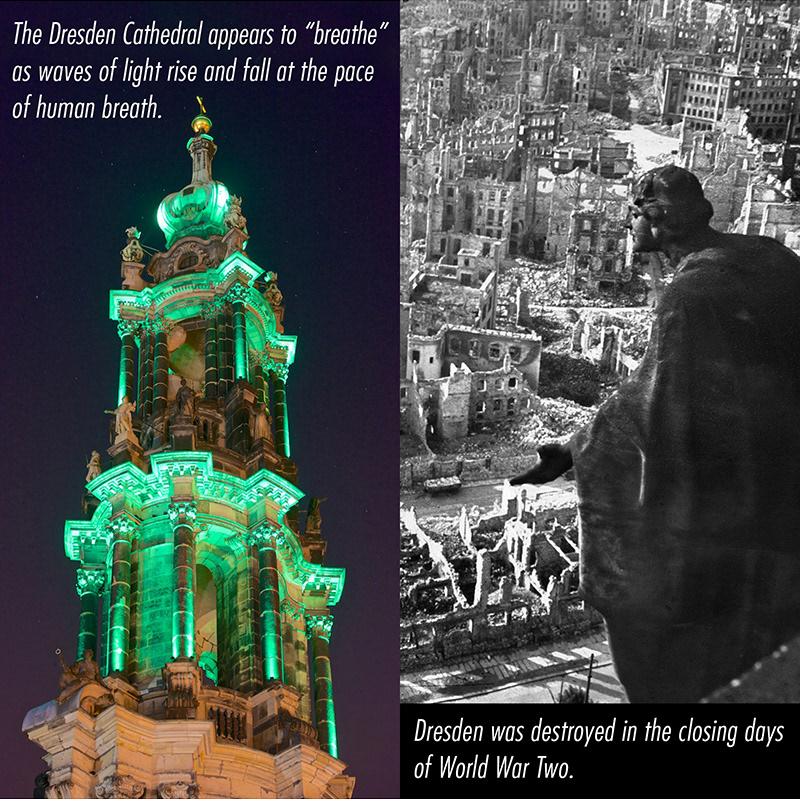
Here is a public artwork linking two former adversaries from WWII — the single most deadly war in human history — offering a breathing beacon of hope, and a compelling message for reconciliation. The Dresden Cathedral (c.1738) is one of Dresden’s foremost historic landmarks. With its prominent setting on the River Elbe, it is a key component of Dresden’s historic “silhouette,” and with its soaring Baroque tower rising high above the city, a light installation here became an artwork on the scale of the cityscape. (All lighting was computer-controlled, energy-efficient, LED technology.)
Endorsed By:
City of Dresden, Mayor’s Office • Free State of Saxony • Dresden Department of Culture and Monument Preservation
• Dresden Kathedrale (Ss. Trinitatis) • U.S. Embassy, Berlin • U.S. Consulate, Leipzig • Allianz Kulturstiftung, Berlin
• Volkswagen, Wolfsburg • Buckingham Palace, London • The Dresden Trust, London • The Bishop of Coventry, UK
• The White House, Washington, DC • The German Consulate, New York • Deutsches Haus, New York University
• Kurt Vonnegut Memorial Library, Indianapolis • Taubman College of Architecture, University of Michigan
• Dresden Sister City Inc. • Columbus Sister Cities International • City of Columbus, Mayor’s Office
• Columbus Art Commission International • Columbus Public Art 2012
Sponsored By:
The New York Foundation for the Arts • City of Dresden • Dresden Sister City Inc. • Columbus Sister Cities International
• U.S. Consulate, Leipzig • U.S. Embassy, Berlin • Hotel Taschenbergpalais Kempinski Dresden
• Westin Bellevue Dresden • WildKat PR, Berlin • an Anonymous Foundation in New York • & Dozens of individuals
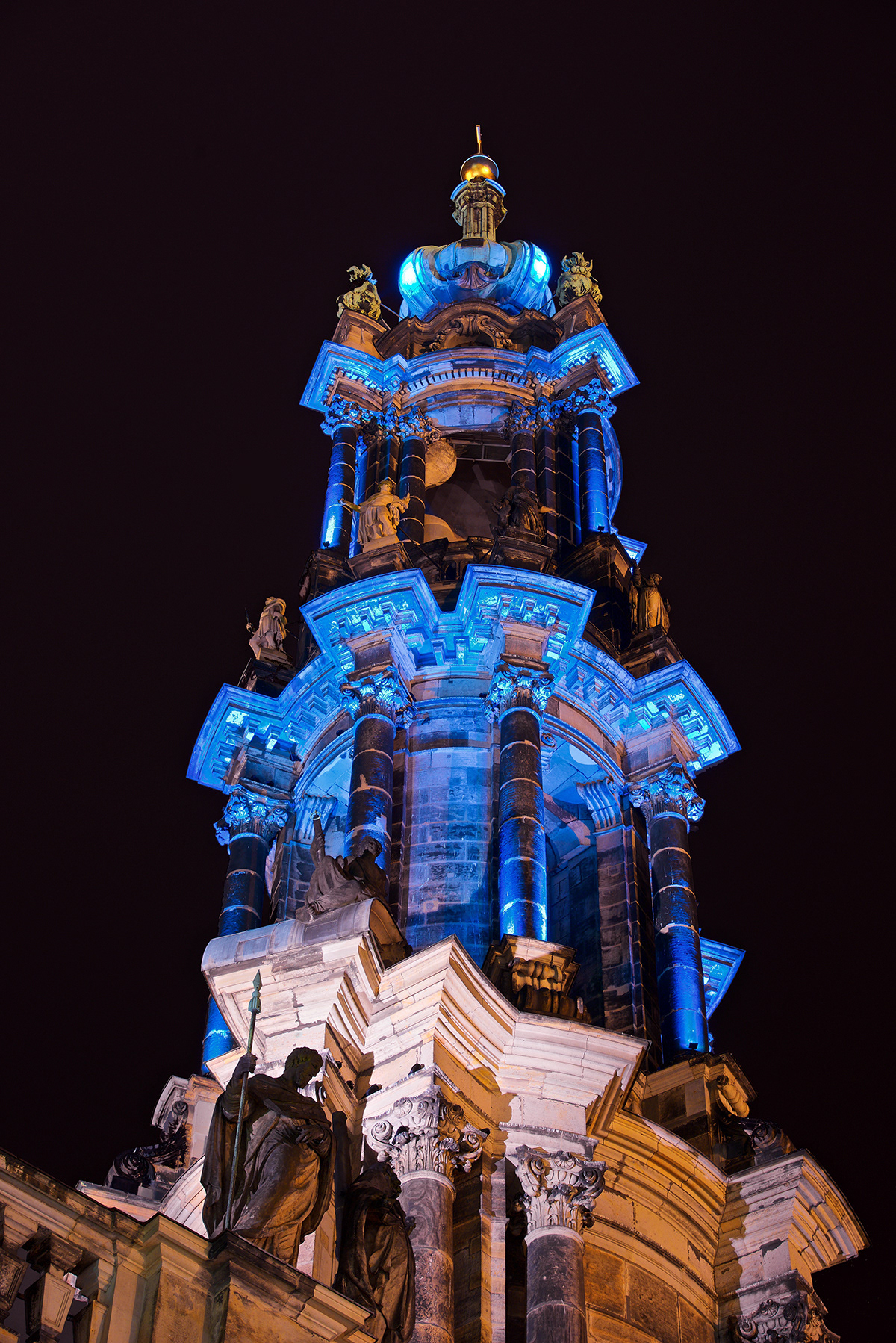
In the closing days of World War II, three days and nights of Allied bombing created a devastating firestorm which incinerated Dresden… a Baroque city of unparalleled architectural treasures. The destruction of Dresden —
Florence on the Elbe — was a profound loss to the cultural heritage of the whole world.
Florence on the Elbe — was a profound loss to the cultural heritage of the whole world.
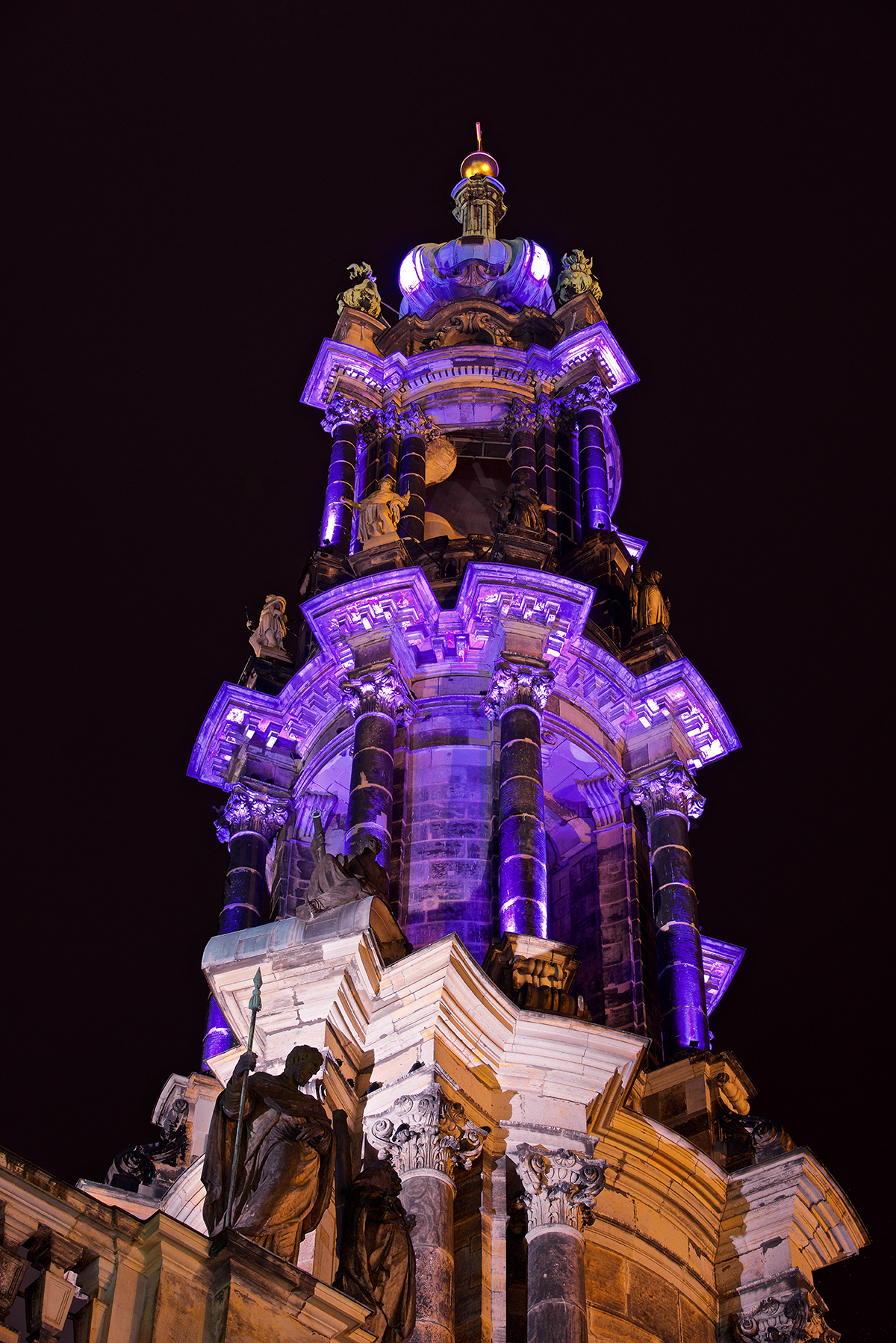
Said the artist, “As an American artist, and as the son of an American soldier who was fighting with the Allied forces in Germany when Dresden was bombed, I see this project as a humble gesture for peace and reconciliation.”
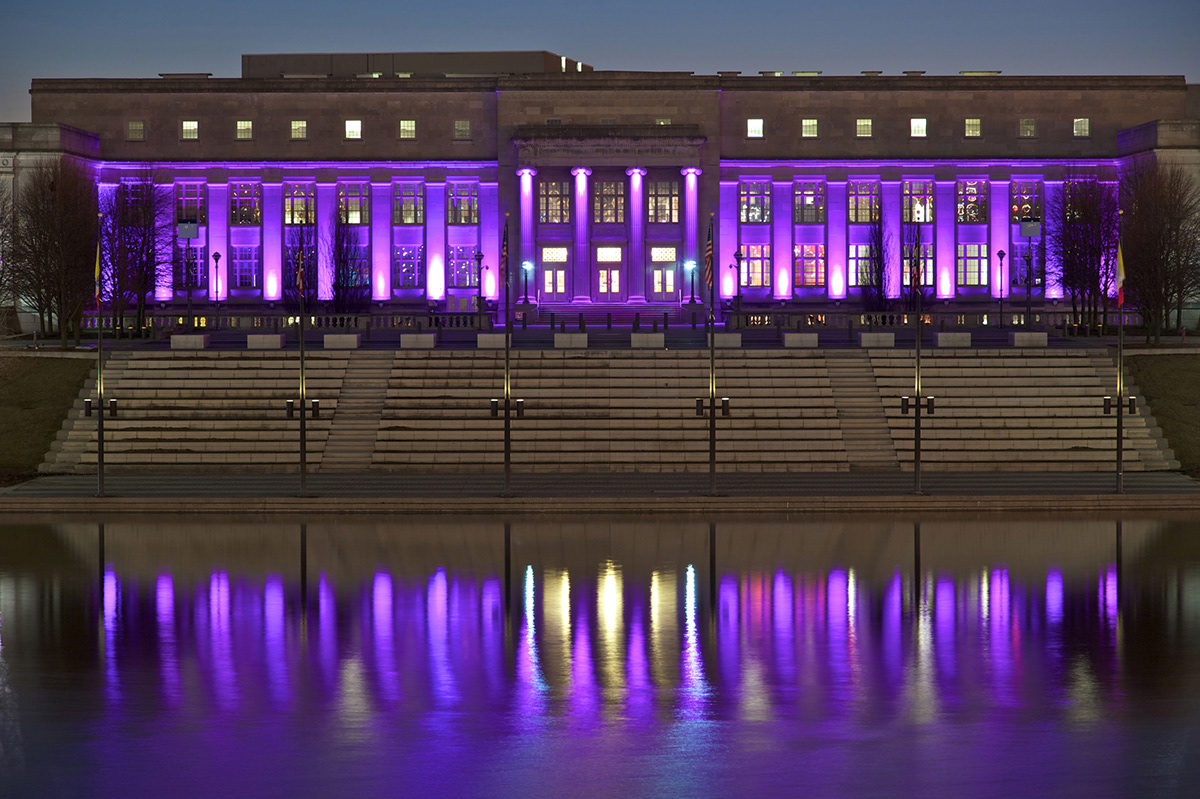
What led to the installation of this project in Dresden?
In 2011 Williams was commissioned to create a large scale outdoor installation in downtown Columbus, Ohio. “Breath of Life/Columbus” (above) was installed in 2012. During the planning of the Columbus project, Columbus Sister Cities International and Dresden Sister City Inc. commissioned Williams to travel to Dresden, Germany (sister city to Columbus) to research potential sites for a “sister installation” in Dresden. Seed money was provided by both organizations, as well as by the City of Dresden, and planning and fund raising continued for more than 3 years. In 2014, plans for the Dresden installation took on even deeper symbolic meaning, as the City of Dresden welcomed the suggestion of Dresden Sister City Inc., to have “Breath of Life/Dresden” take place in February 2015 to coincide with the
70th anniversary observance of the bombing of Dresden. Photo © Craig Collins 2012.
Was führte zu diesem Projekt in Dresden?
Im Jahre 2011 erhielt Williams den Auftrag, eine großflächige Außeninstallation im Zentrum der Stadt Columbus (Ohio) zu kreieren. „Breath of Life/Columbus“ (oben) wurde 2012 installiert. In der Planungsphase des Columbuser Projektes baten Columbus Sister Cities International und Dresden Sister City, Inc. Williams, nach Dresden zu reisen und mögliche Standorte für eine „Parallelinstallation“ in Columbus‘ Partnerstadt zu erkunden. Beide Organisationen und die Stadt Dresden unterstützten den Künstler dabei finanziell, und seit zwei Jahren laufen nun die Vorbereitungen und Kapitalbeschaffung für das Projekt. Inzwischen hat die Dresden-Installation eine noch tiefere Bedeutung erhalten, und zwar durch die Idee der Städtepartnerschaftsorganisation Dresden Sister City, Inc., „Lebensatem/Dresden“ im Februar 2015, parallel zu den Gedenkveranstaltungen zum 70. Jahrestag der Bombenangriffe auf die Stadt, zu installieren,
und die Stadt Dresden steht diesem Vorschlag offen gegenüber.
In 2011 Williams was commissioned to create a large scale outdoor installation in downtown Columbus, Ohio. “Breath of Life/Columbus” (above) was installed in 2012. During the planning of the Columbus project, Columbus Sister Cities International and Dresden Sister City Inc. commissioned Williams to travel to Dresden, Germany (sister city to Columbus) to research potential sites for a “sister installation” in Dresden. Seed money was provided by both organizations, as well as by the City of Dresden, and planning and fund raising continued for more than 3 years. In 2014, plans for the Dresden installation took on even deeper symbolic meaning, as the City of Dresden welcomed the suggestion of Dresden Sister City Inc., to have “Breath of Life/Dresden” take place in February 2015 to coincide with the
70th anniversary observance of the bombing of Dresden. Photo © Craig Collins 2012.
Was führte zu diesem Projekt in Dresden?
Im Jahre 2011 erhielt Williams den Auftrag, eine großflächige Außeninstallation im Zentrum der Stadt Columbus (Ohio) zu kreieren. „Breath of Life/Columbus“ (oben) wurde 2012 installiert. In der Planungsphase des Columbuser Projektes baten Columbus Sister Cities International und Dresden Sister City, Inc. Williams, nach Dresden zu reisen und mögliche Standorte für eine „Parallelinstallation“ in Columbus‘ Partnerstadt zu erkunden. Beide Organisationen und die Stadt Dresden unterstützten den Künstler dabei finanziell, und seit zwei Jahren laufen nun die Vorbereitungen und Kapitalbeschaffung für das Projekt. Inzwischen hat die Dresden-Installation eine noch tiefere Bedeutung erhalten, und zwar durch die Idee der Städtepartnerschaftsorganisation Dresden Sister City, Inc., „Lebensatem/Dresden“ im Februar 2015, parallel zu den Gedenkveranstaltungen zum 70. Jahrestag der Bombenangriffe auf die Stadt, zu installieren,
und die Stadt Dresden steht diesem Vorschlag offen gegenüber.
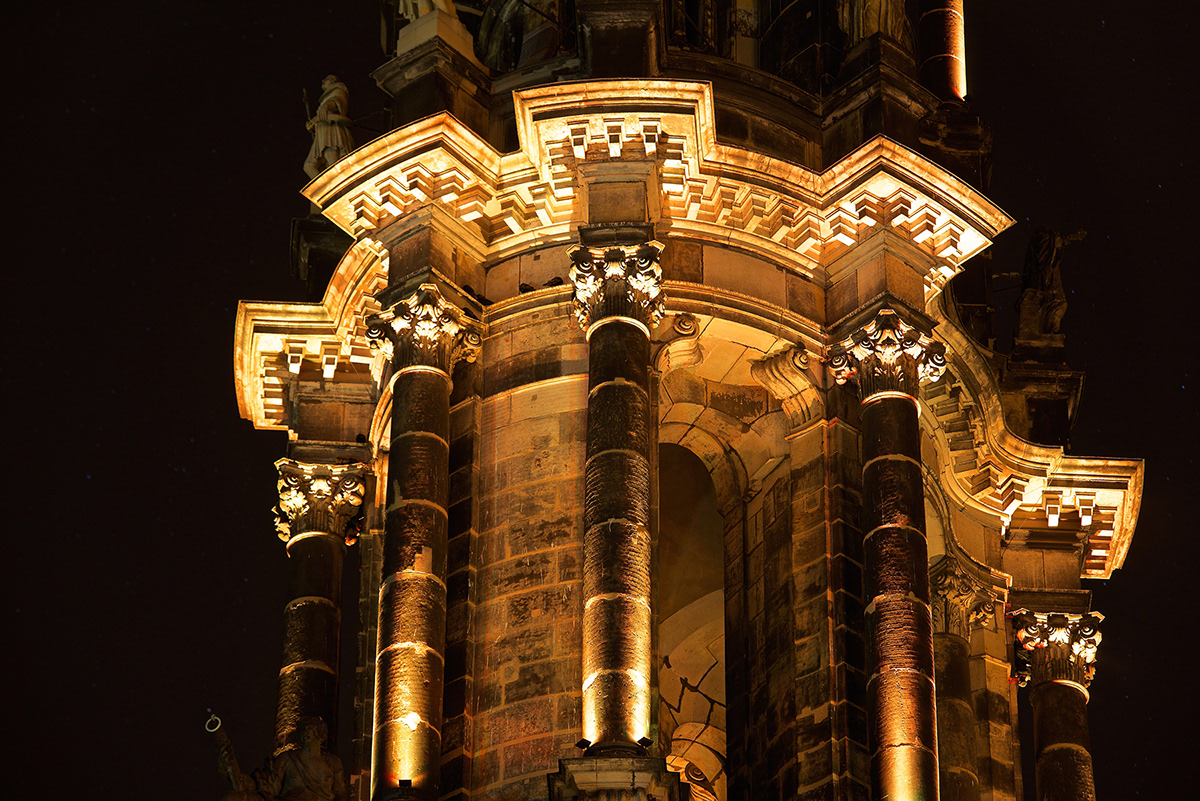

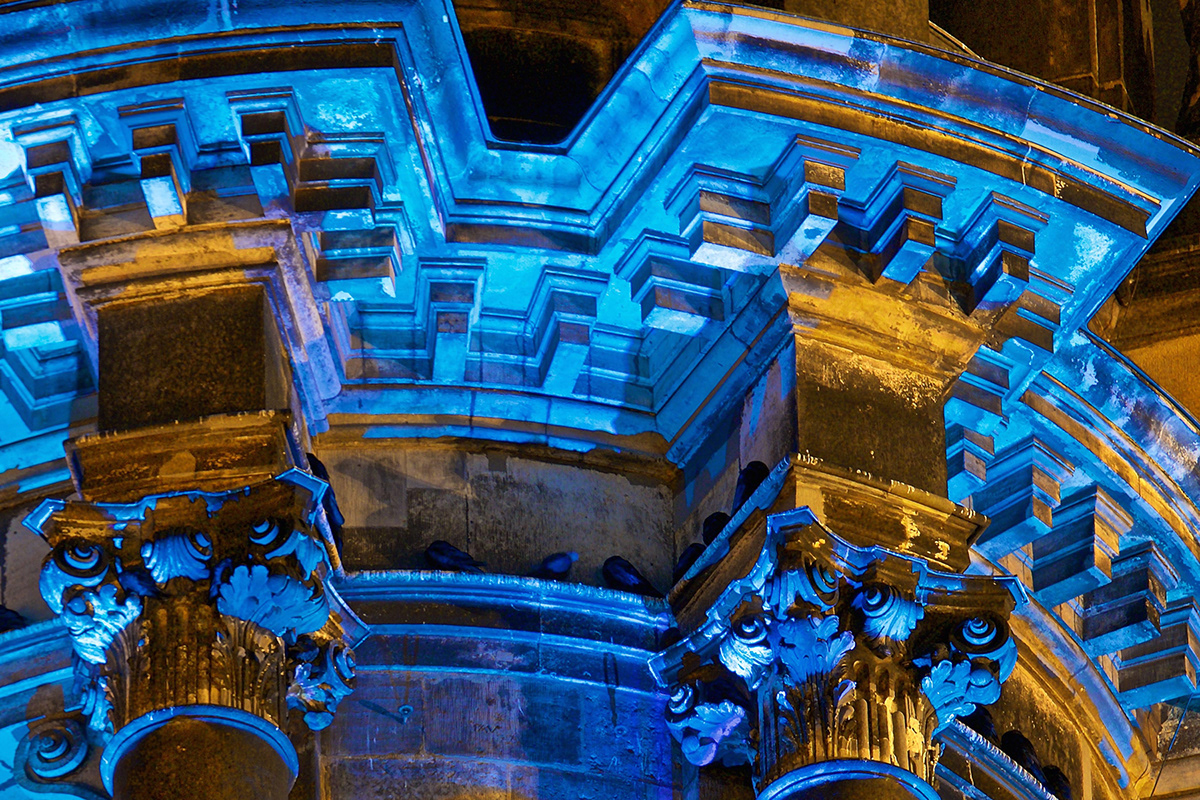
Detail photo. Working with lighting technicians, the artist composed a visual score that was programmed into a digital data controller, which in turn orchestrated the pace of the up-lighting on the tower as waves of light rose and fell at the pace of human breath, and revealed the richly detailed facade in ways it had never before been seen.
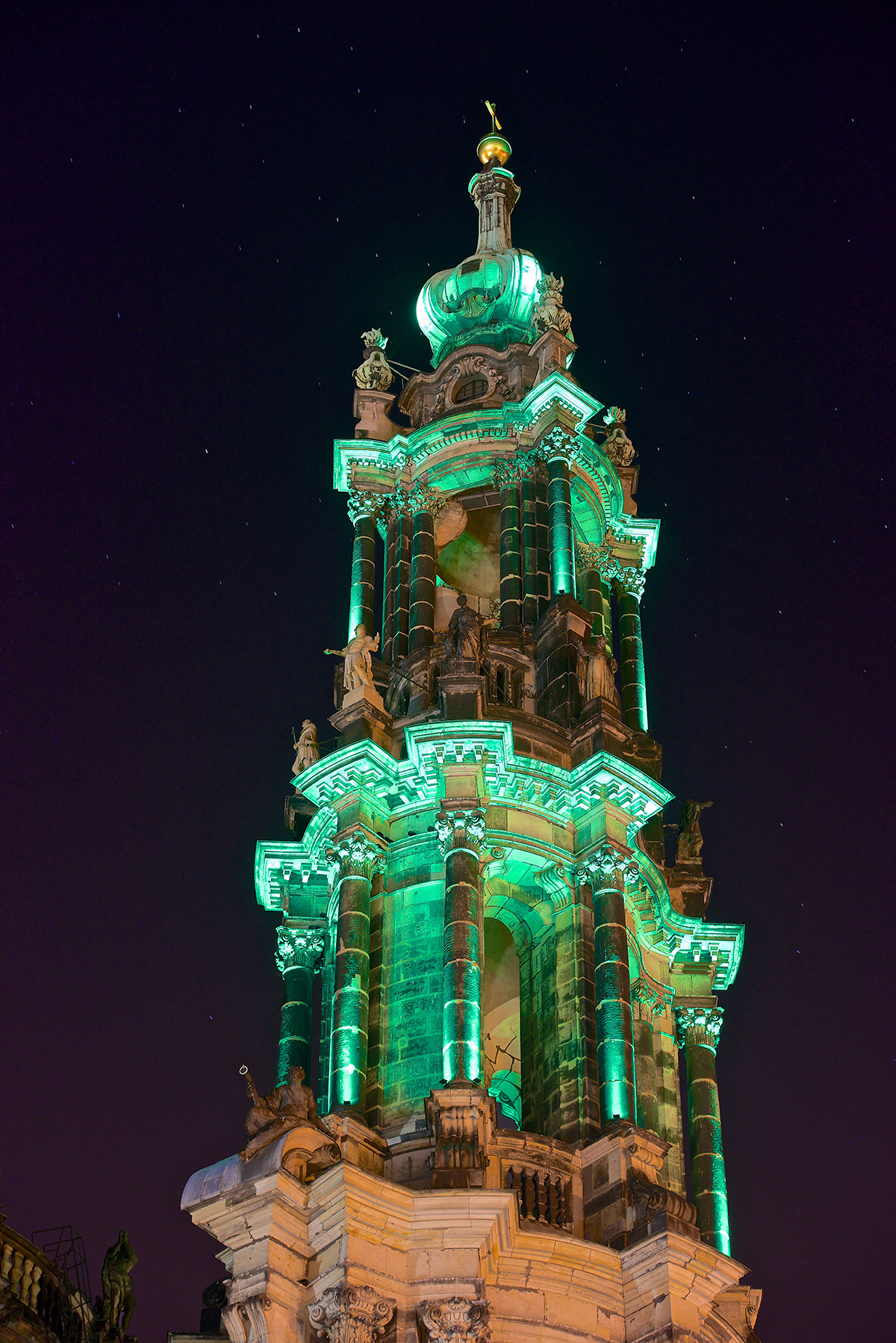
Artist’s Speech at the Opening Ceremony in Dresden on February 13, 2015:
“As an American artist, and as the son of an American soldier who fought with the Allied troops in WWII, I would like to thank the City of Dresden, the Free State of Saxony, and the Dresden Kathedrale for welcoming me to install “Breath of Life/Dresden” to coincide with the 70th anniversary observance of the bombing of Dresden.
By using the most basic medium of light, the Kathedrale appears to “breathe,” as waves of light rise and fall at the pace of human breath. Given Dresden’s destruction in the closing days of World War II, I think the vision of one of this city’s foremost historic landmarks appearing to “breathe,” is extremely moving. As a Baroque city of unparalleled architectural treasures, I think Dresden’s destruction was a profound loss to the cultural heritage of the whole world.
Here is a public artwork linking two former adversaries from WWII — the single most deadly war in human history — offering a breathing beacon of hope, and a compelling message for world peace. For three long years I’ve been working on the planning and fund raising for this complex and very challenging art installation. Fund raising has fallen short, but by dipping into my own personal life savings, I am today, on this night, 70 years on from an event that has become an icon in the annals of the horrors of war, honored to be able to offer “Breath of Life/Dresden” as my gift to the
City of Dresden, free and for all to see.”
“As an American artist, and as the son of an American soldier who fought with the Allied troops in WWII, I would like to thank the City of Dresden, the Free State of Saxony, and the Dresden Kathedrale for welcoming me to install “Breath of Life/Dresden” to coincide with the 70th anniversary observance of the bombing of Dresden.
By using the most basic medium of light, the Kathedrale appears to “breathe,” as waves of light rise and fall at the pace of human breath. Given Dresden’s destruction in the closing days of World War II, I think the vision of one of this city’s foremost historic landmarks appearing to “breathe,” is extremely moving. As a Baroque city of unparalleled architectural treasures, I think Dresden’s destruction was a profound loss to the cultural heritage of the whole world.
Here is a public artwork linking two former adversaries from WWII — the single most deadly war in human history — offering a breathing beacon of hope, and a compelling message for world peace. For three long years I’ve been working on the planning and fund raising for this complex and very challenging art installation. Fund raising has fallen short, but by dipping into my own personal life savings, I am today, on this night, 70 years on from an event that has become an icon in the annals of the horrors of war, honored to be able to offer “Breath of Life/Dresden” as my gift to the
City of Dresden, free and for all to see.”

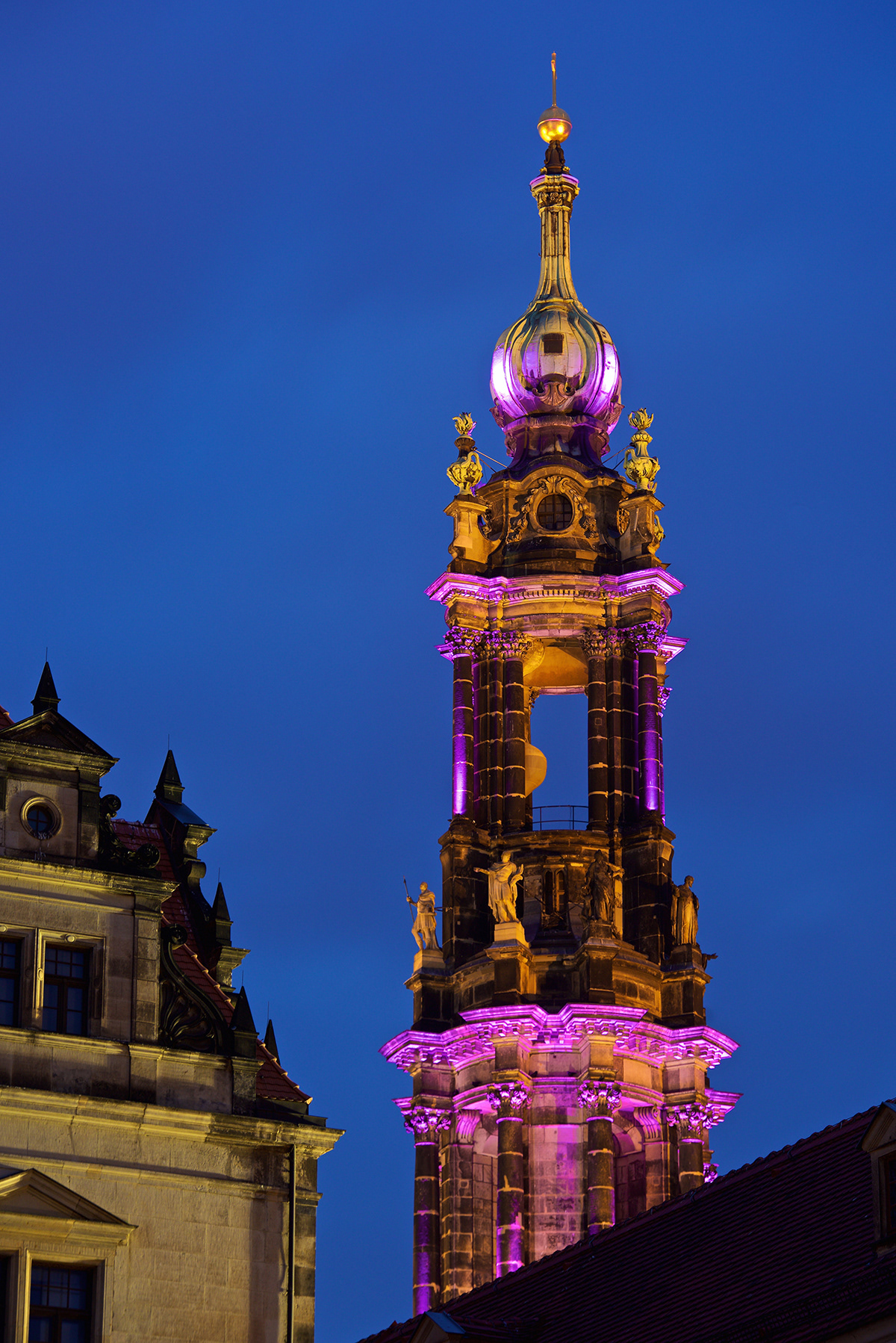
During a 2009 sabbatical in Paris — ‘‘The City of Light” — Williams developed his concept for simulating human breath on architectural facades by introducing computer controlled waves of energy-efficient LED uplighting.

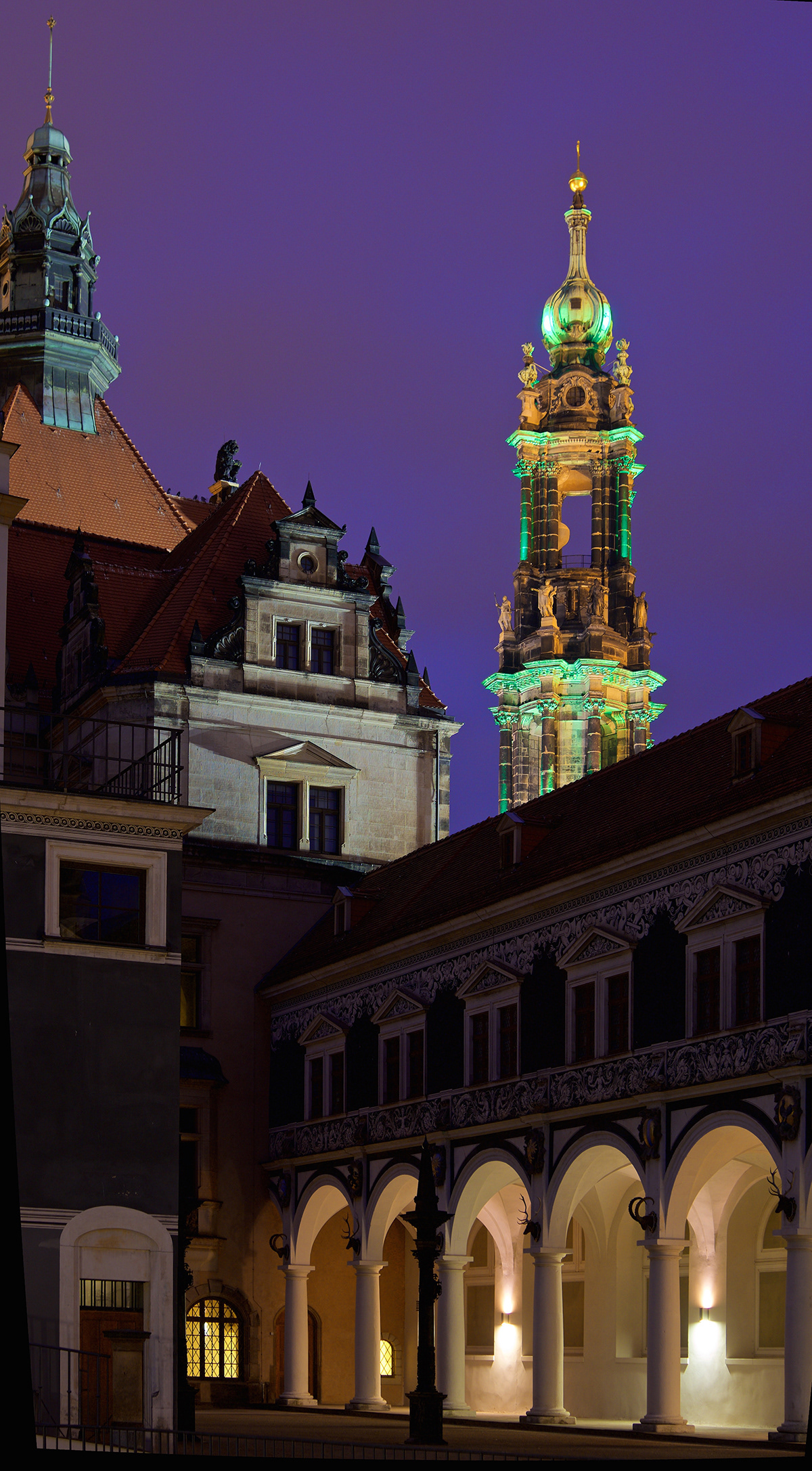
Known for centuries as one of Europe’s most beautiful cities — Florence on the Elbe — Dresden held little significance as a military or industrial center. Tens of thousands died in the firebombing of Dresden in February 1945, and with them, the leveling of a Baroque city of unparalleled architectural treasures was a profound loss to the cultural heritage of
the whole world. Said the artist, “The irony is not lost on me that I am a citizen of one of the two nations that
destroyed Dresden.”
the whole world. Said the artist, “The irony is not lost on me that I am a citizen of one of the two nations that
destroyed Dresden.”

Dresden’s compelling story and its iconic standing in the annals of the horrors of war have been nearly forgotten or are relatively unknown by many younger generations. “Breath of Life / Dresden” offers an opportunity to restore lost history and to begin a conversation about the tragic destruction of one of the world’s great cities.
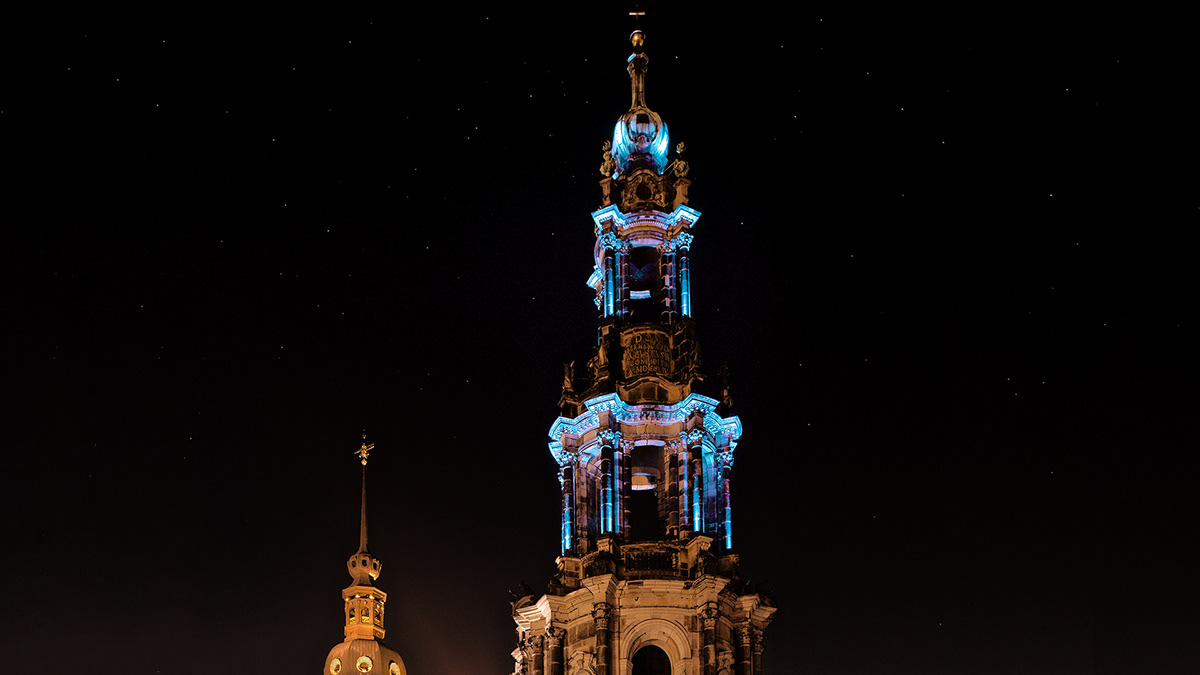
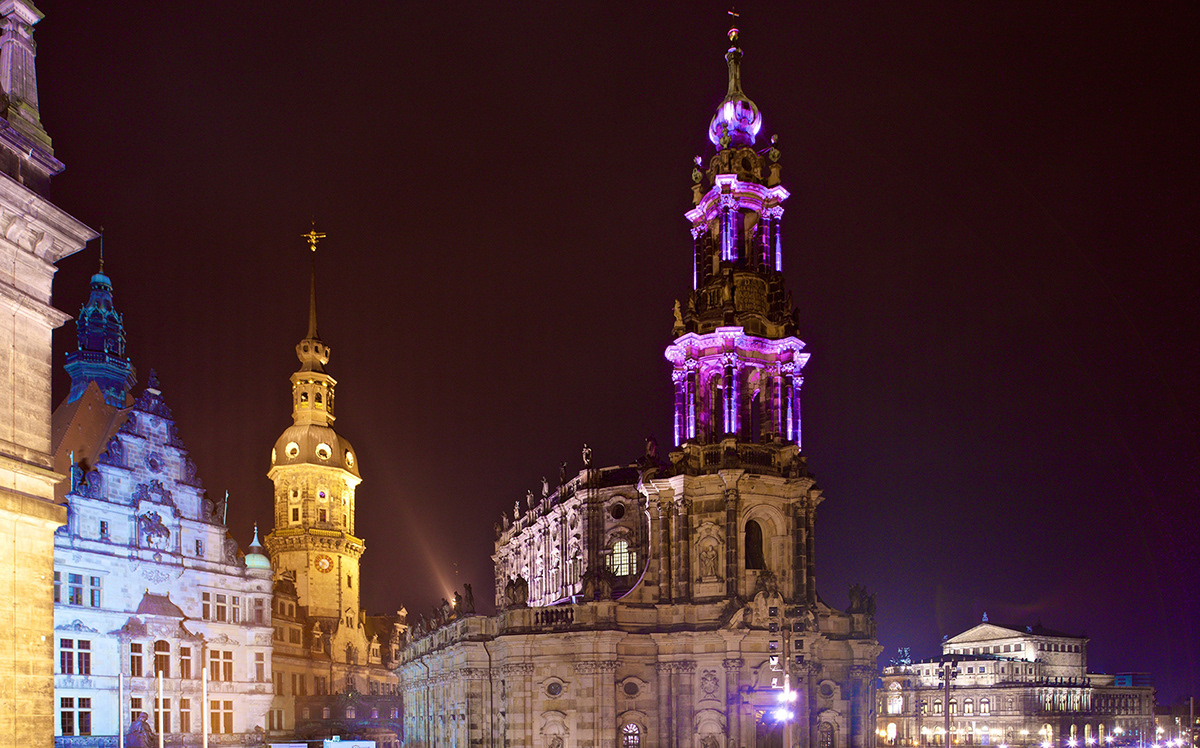
(Deutsch)
In den Worten Kurt Vonneguts, des Autors von „Schlachthof Nummer 5“:
„Ich hätte mein Leben gegeben, um Dresden für die nächsten Generationen zu retten. So sollten wir alle über jede Stadt dieser Erde denken.“
„Angesichts der fast vollständigen Zerstörung Dresdens im Februar 1945 denke ich, dass ein scheinbar atmendes historisches Gebäude dieser Stadt ein tief bewegender Anblick sein wird. Als Künstler sehe ich das Projekt auch als Möglichkeit, dem Überleben und Wiederaufbau einer wunderschönen Stadt Respekt zu zollen. Letztendlich ist das eine Lebensbejahung.” — Stuart Williams
Sponsoren: Landeshauptstadt Dresden, Büro der Oberbürgermeisterin; Verein zur Förderung der Städtepartnerschaft Columbus-Dresden in Columbus; Verein zur Förderung der Städtepartnerschaften von Columbus; U.S. Consulate, Leipzig; U.S. Embassy, Berlin; Westin Bellevue Dresden; Hotel Taschenbergpalais Kempinski Dresden; Stagelight, Coesfeld, Deutschland.
Das Projekt wird von den folgenden Organisationen unterstützt:
Landeshauptstadt Dresden, Büro der Oberbürgermeisterin, sowie Amt für Kultur und Denkmalschutz; Freistaat Sachsen; Dresden Kathedrale Ss. Trinitatis; City of Columbus, Mayor’s Office; Dresden Sister City, Inc.; Columbus Sister Cities International; Columbus Art Commission International, Columbus Public Art 2012.
In den Worten Kurt Vonneguts, des Autors von „Schlachthof Nummer 5“:
„Ich hätte mein Leben gegeben, um Dresden für die nächsten Generationen zu retten. So sollten wir alle über jede Stadt dieser Erde denken.“
„Angesichts der fast vollständigen Zerstörung Dresdens im Februar 1945 denke ich, dass ein scheinbar atmendes historisches Gebäude dieser Stadt ein tief bewegender Anblick sein wird. Als Künstler sehe ich das Projekt auch als Möglichkeit, dem Überleben und Wiederaufbau einer wunderschönen Stadt Respekt zu zollen. Letztendlich ist das eine Lebensbejahung.” — Stuart Williams
Sponsoren: Landeshauptstadt Dresden, Büro der Oberbürgermeisterin; Verein zur Förderung der Städtepartnerschaft Columbus-Dresden in Columbus; Verein zur Förderung der Städtepartnerschaften von Columbus; U.S. Consulate, Leipzig; U.S. Embassy, Berlin; Westin Bellevue Dresden; Hotel Taschenbergpalais Kempinski Dresden; Stagelight, Coesfeld, Deutschland.
Das Projekt wird von den folgenden Organisationen unterstützt:
Landeshauptstadt Dresden, Büro der Oberbürgermeisterin, sowie Amt für Kultur und Denkmalschutz; Freistaat Sachsen; Dresden Kathedrale Ss. Trinitatis; City of Columbus, Mayor’s Office; Dresden Sister City, Inc.; Columbus Sister Cities International; Columbus Art Commission International, Columbus Public Art 2012.
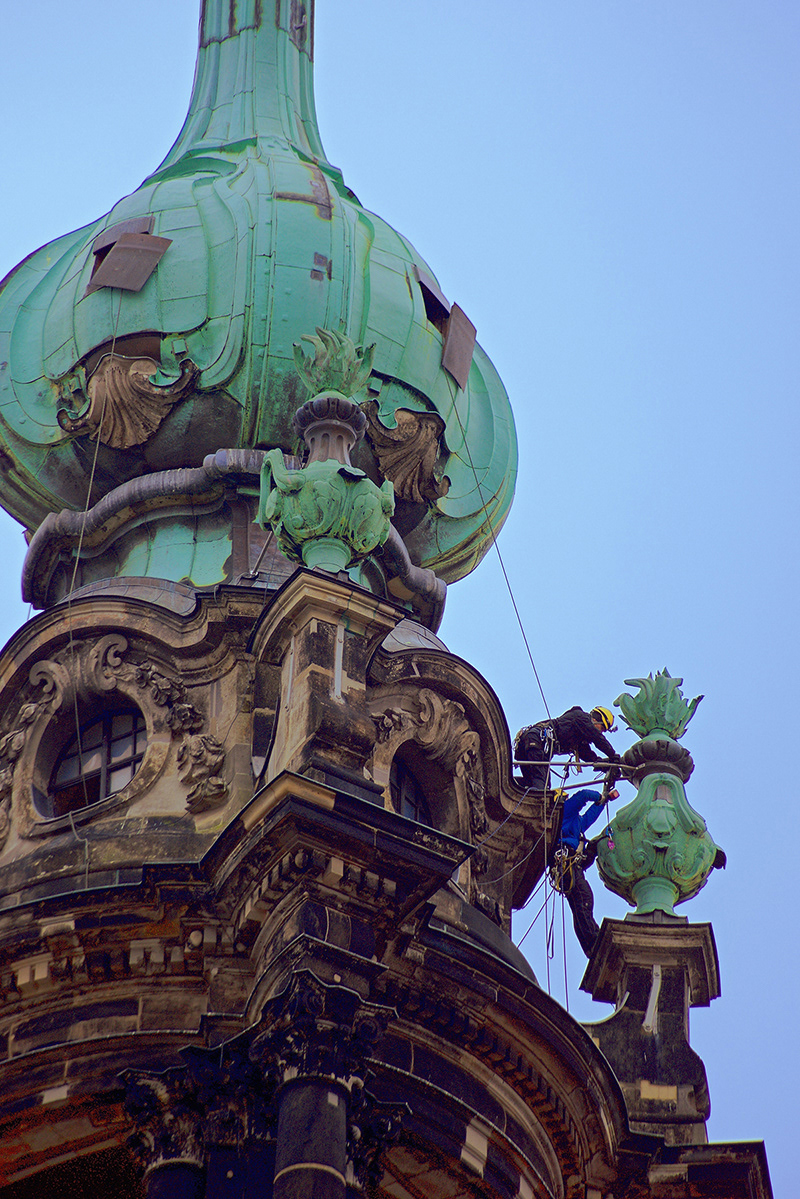
An installation crew of three “climbers” and two lighting technicians secured 28 LED lamp fixtures at three levels of the 83 meter (275 foot) bell tower. Climbers are highly trained workers who have adapted the skills of Alpine mountain climbers to scaling historic towers and facades in Europe for maintenance and repair.
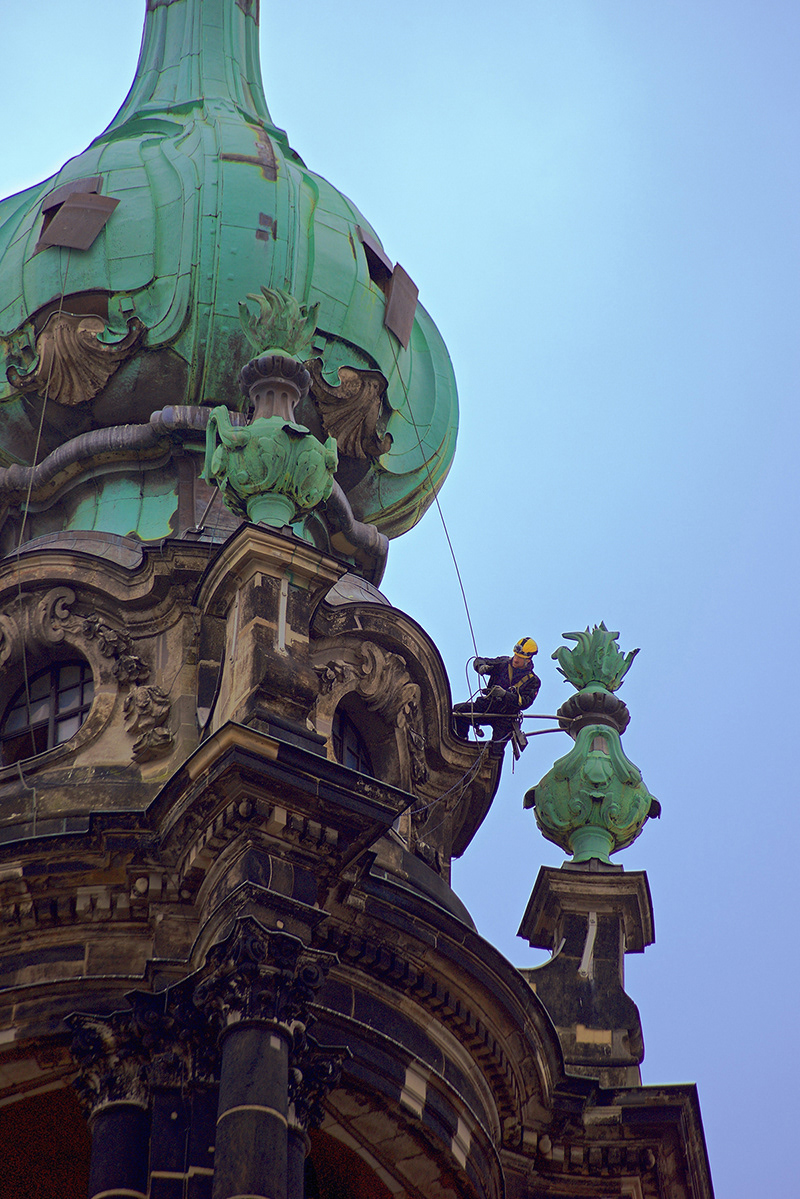
600 meters (1968 feet) of electrical cable were threaded through the interior of the tower to be visually unobtrusive,
and provided power to the computer-controlled, energy-efficient LED lighting system.
and provided power to the computer-controlled, energy-efficient LED lighting system.
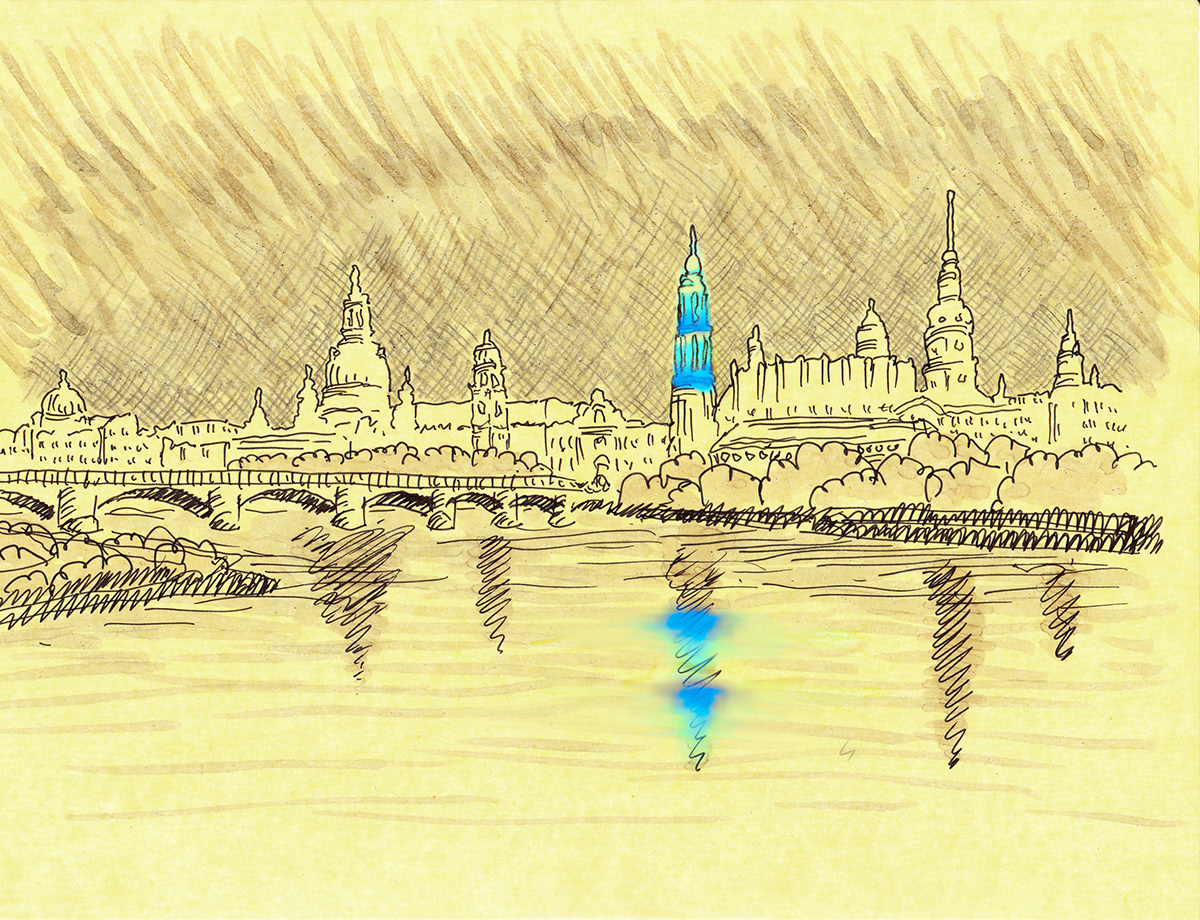
Artist’s sketch (above) simulates the project as seen from the Marienbrücke (bridge over the River Elbe).
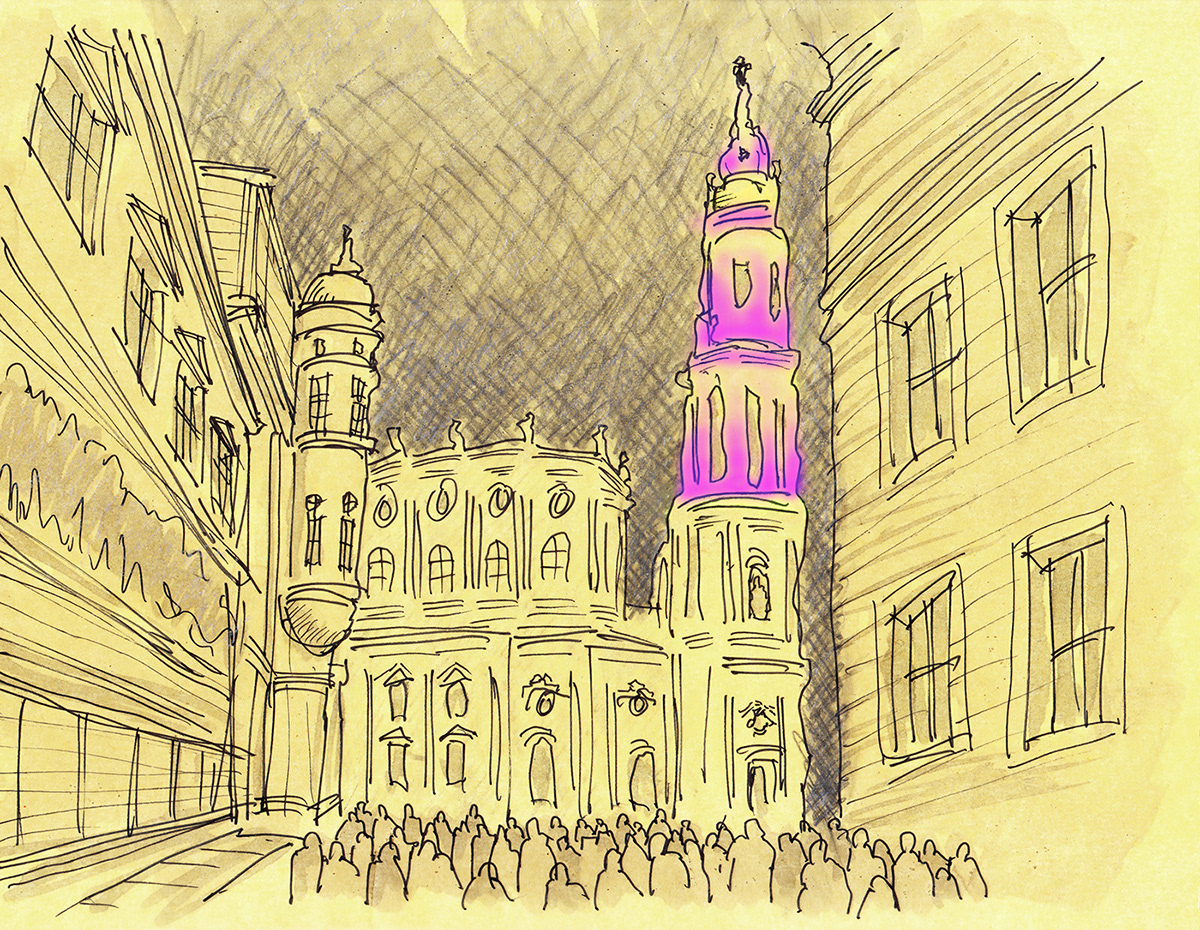
Artist’s sketch (above) simulates the project as seen from Augustusstraße.

Above is a recent photo of Dresden’s famous “silhouette” along the River Elbe. All of the buildings in this photo, along with most of the historic city center, were virtually demolished in the bombing of Dresden in 1945. The Kathedrale Ss. Trinitatis (c.1738) is the project site, and is the tower on the far right. In the mid 1980s — forty years after WWII — it was meticulously rebuilt. The Frauenkirche (the large dome on the far left) was built in 1726. The dome collapsed during the fire storm ignited by the bombing. Its reconstruction was completed in 2004, thus finally restoring Dresden’s historic silhouette to what it had been for centuries. Photo © Stuart Williams.
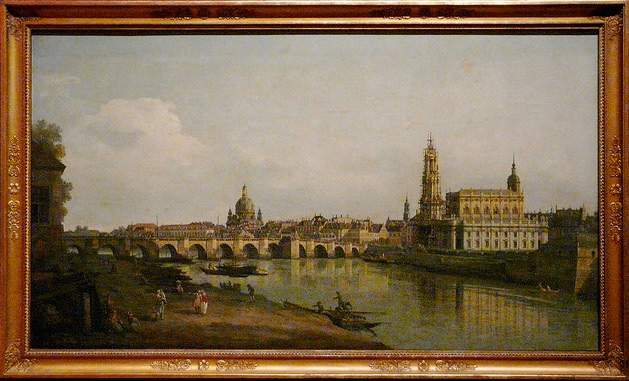
The Venetian painter Canaletto (1722–1780) painted this view of Dresden’s “silhouette” in 1748. The Dresden Cathedral — the project site — is the tallest tower on the right.
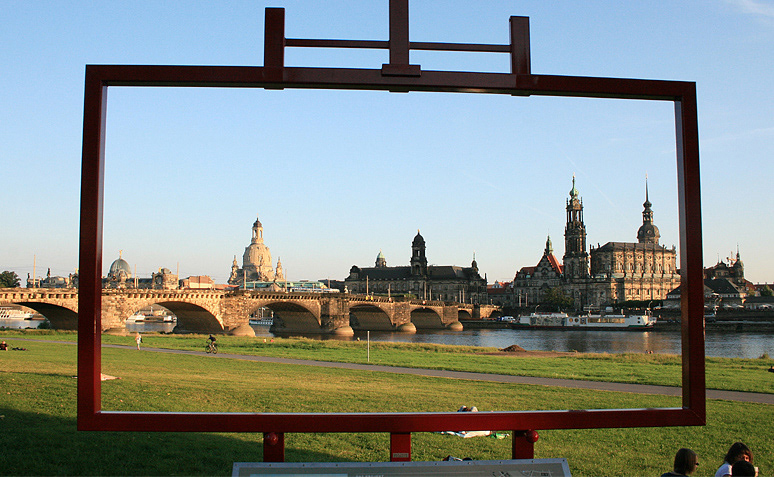
Canaletto’s View: Three historical views of Dresden by the painter Canaletto have been marked throughout the city by empty steel frames in the shape of an easel. Each easel frames one of Canaletto’s view points of today’s Dresden and
is accompanied by an image of his corresponding painting (see the painting above).
On a Personal Note: “Ever since I saw the film ‘Slaughterhouse Five’ in 1972, based on Kurt Vonnegut’s seminal novel, I have been haunted by a scene in which American prisoners of war are arriving in Dresden by train... unknowingly, just a few days before the bombing of the city in February 1945. As the train rolls across the River Elbe, the American prisoners are looking out the window and have their first view of Dresden’s famed skyline. One of the Americans says, ‘I’ve never seen anything like it... it’s so beautiful.’ And from that touching scene, it is the distinctive silhouette of the Dresden Kathedrale that has been etched in my memory for all these years.” — Stuart Williams
is accompanied by an image of his corresponding painting (see the painting above).
On a Personal Note: “Ever since I saw the film ‘Slaughterhouse Five’ in 1972, based on Kurt Vonnegut’s seminal novel, I have been haunted by a scene in which American prisoners of war are arriving in Dresden by train... unknowingly, just a few days before the bombing of the city in February 1945. As the train rolls across the River Elbe, the American prisoners are looking out the window and have their first view of Dresden’s famed skyline. One of the Americans says, ‘I’ve never seen anything like it... it’s so beautiful.’ And from that touching scene, it is the distinctive silhouette of the Dresden Kathedrale that has been etched in my memory for all these years.” — Stuart Williams
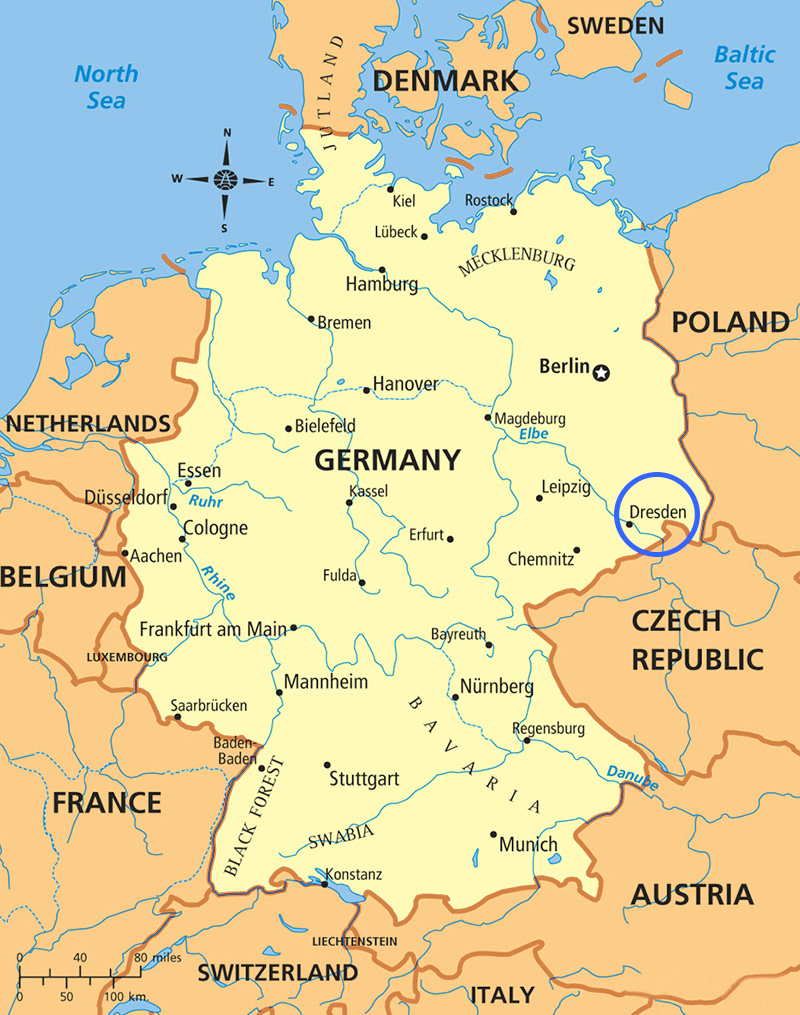
Dresden is the capital of Saxony. It is 164 kilometers (102 miles) south of Berlin, and close to both the Czech
and Polish borders.
and Polish borders.
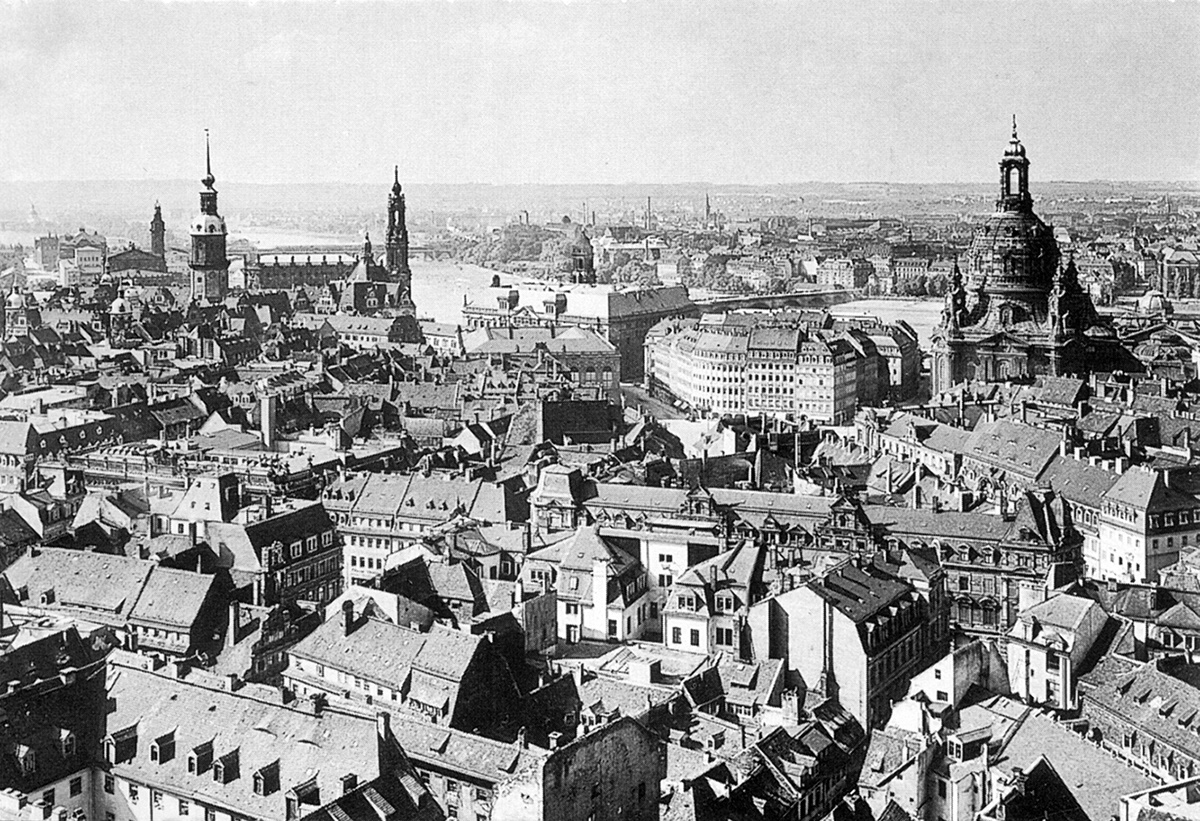
Dresden before it was bombed.
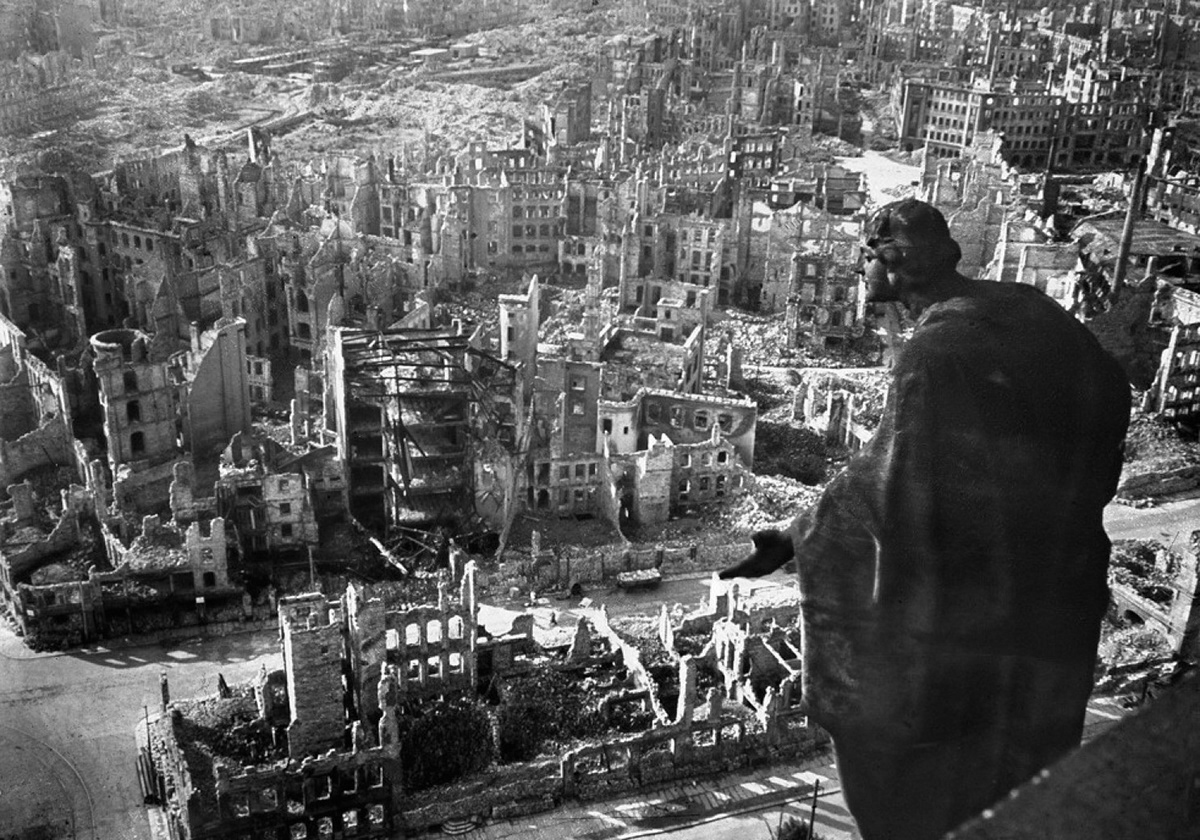
Dresden after it was bombed in February 1945.
“I would have given my life to save Dresden for the world’s generations to come. That is how everyone should feel about every city on Earth.” — Kurt Vonnegut
“I would have given my life to save Dresden for the world’s generations to come. That is how everyone should feel about every city on Earth.” — Kurt Vonnegut
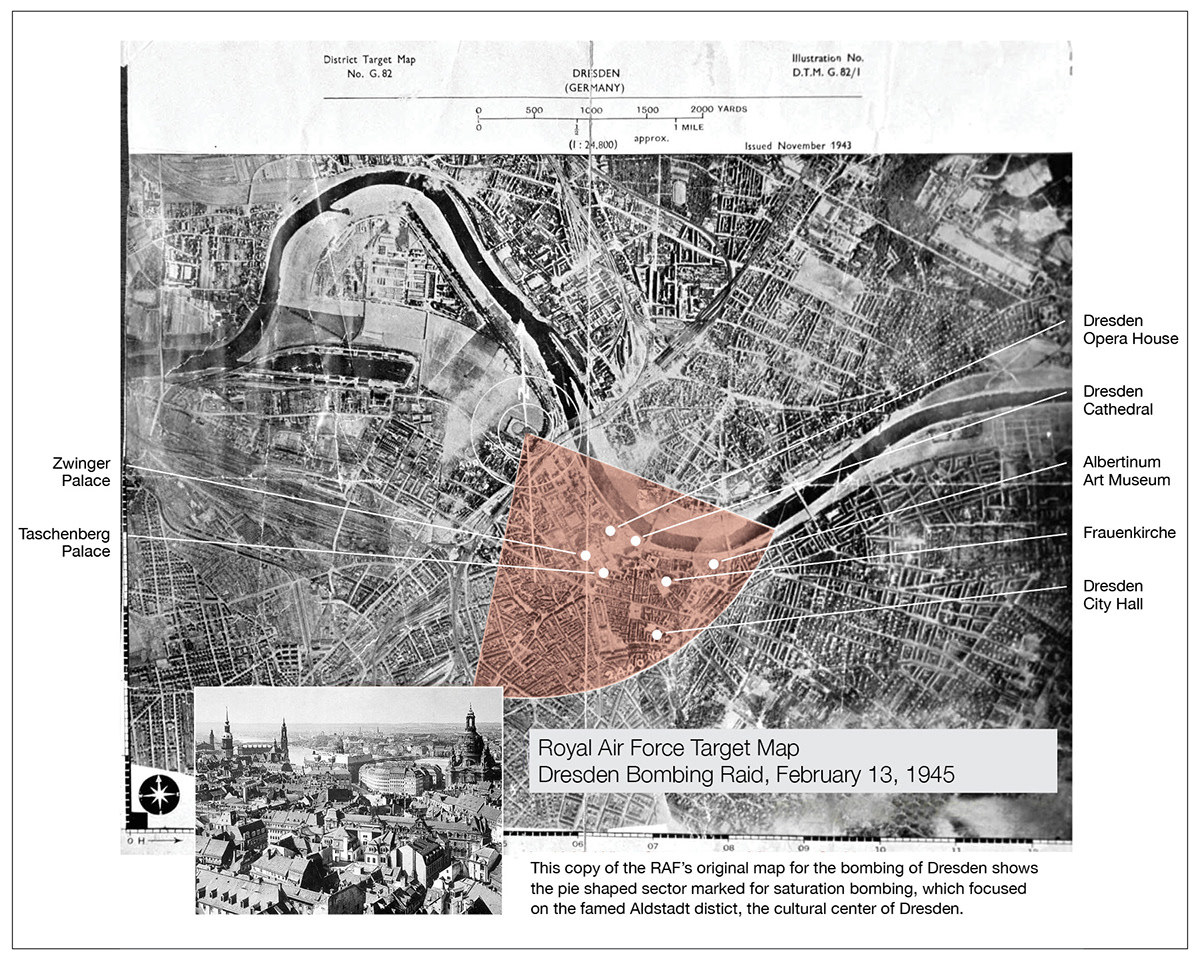
Royal Air Force Target Map. Dresden Bombing Raid 1945.
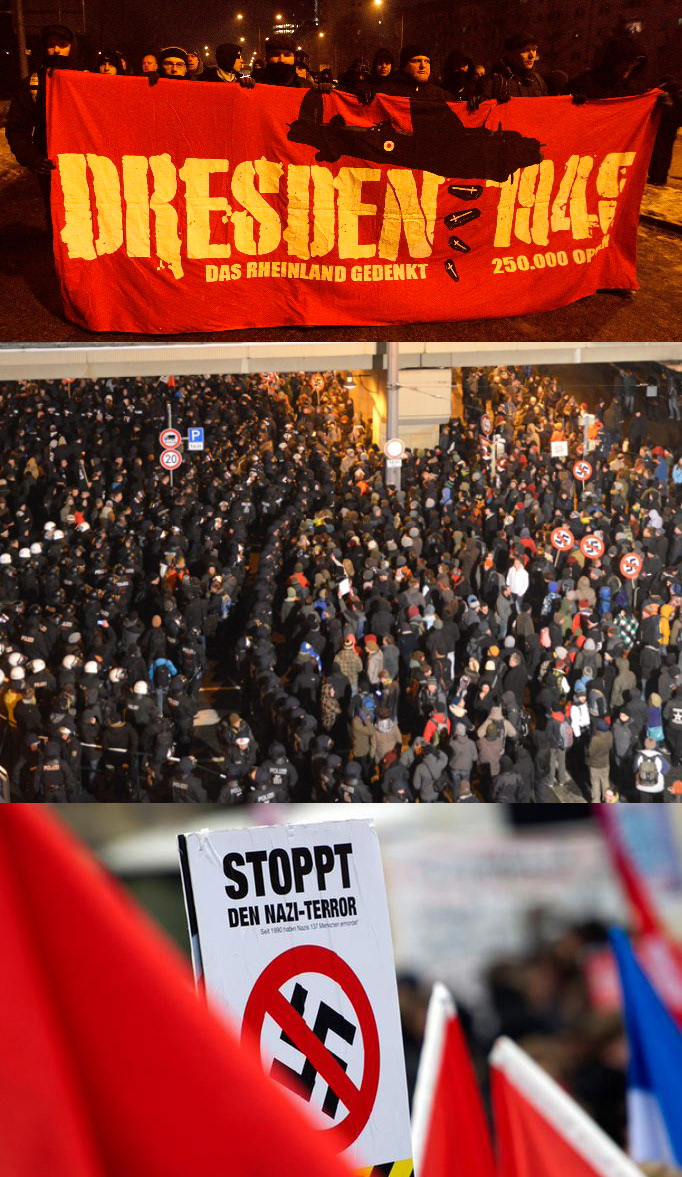
The Annual Observance of the Bombing of Dresden has become a “cause célèbre” for neo-Nazis across Germany. Each year thousands of them come to Dresden to march in protest to what they disturbingly call the “Allied Holocaust,” as even larger groups of peace demonstrators take to the streets to protest Nazism and Fascism. This is, in part, why the City of Dresden welcomed this project to be installed in tandem with the 70th anniversary of the bombing, as they saw it as a silent but powerful message for peace and reconciliation.
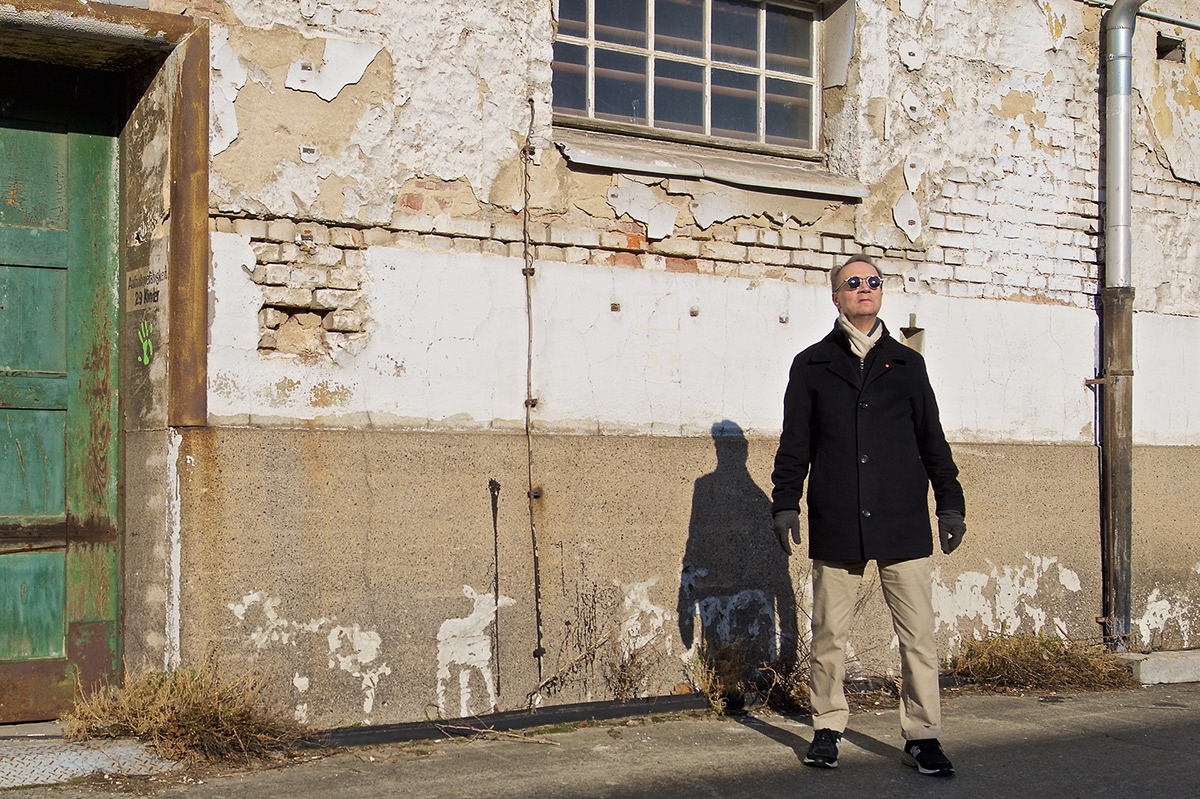
Stuart Williams at the site of the former Slaughterhouse Five on February 13, 2015, the 70th anniversary of the
bombing of Dresden.
bombing of Dresden.
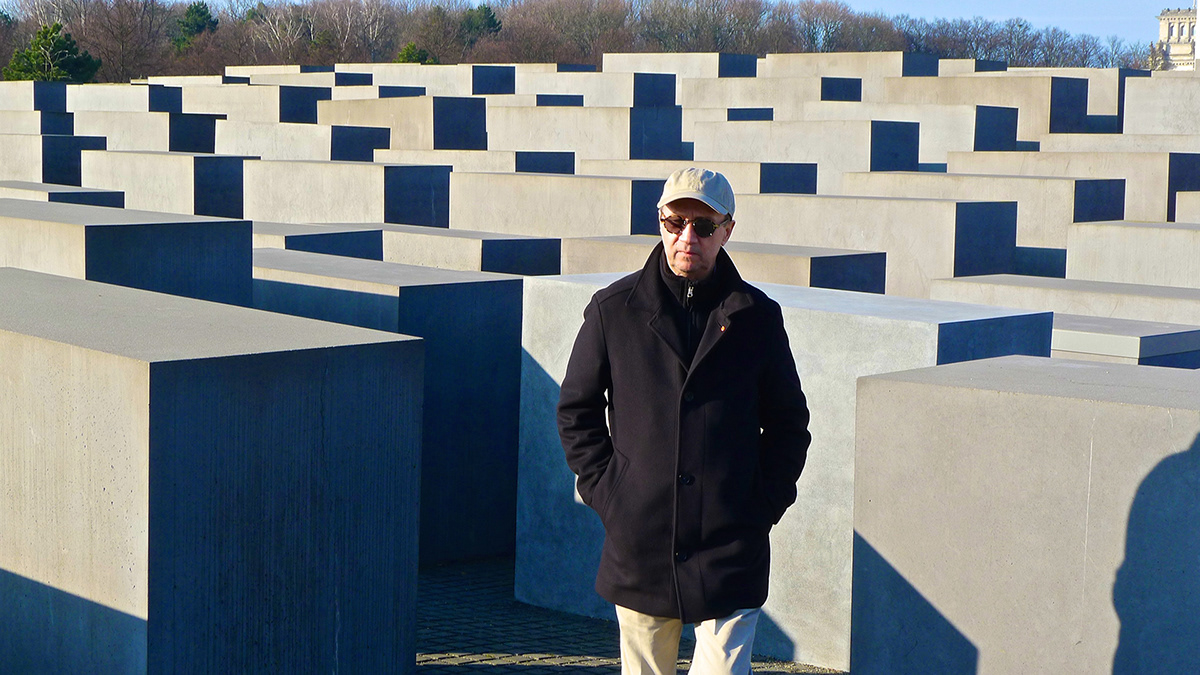
Stuart Williams at the Holocaust Memorial in Berlin, following his installation of “Breath of Life/Dresden”
at the historic Dresden Cathedral in February 2015.
at the historic Dresden Cathedral in February 2015.
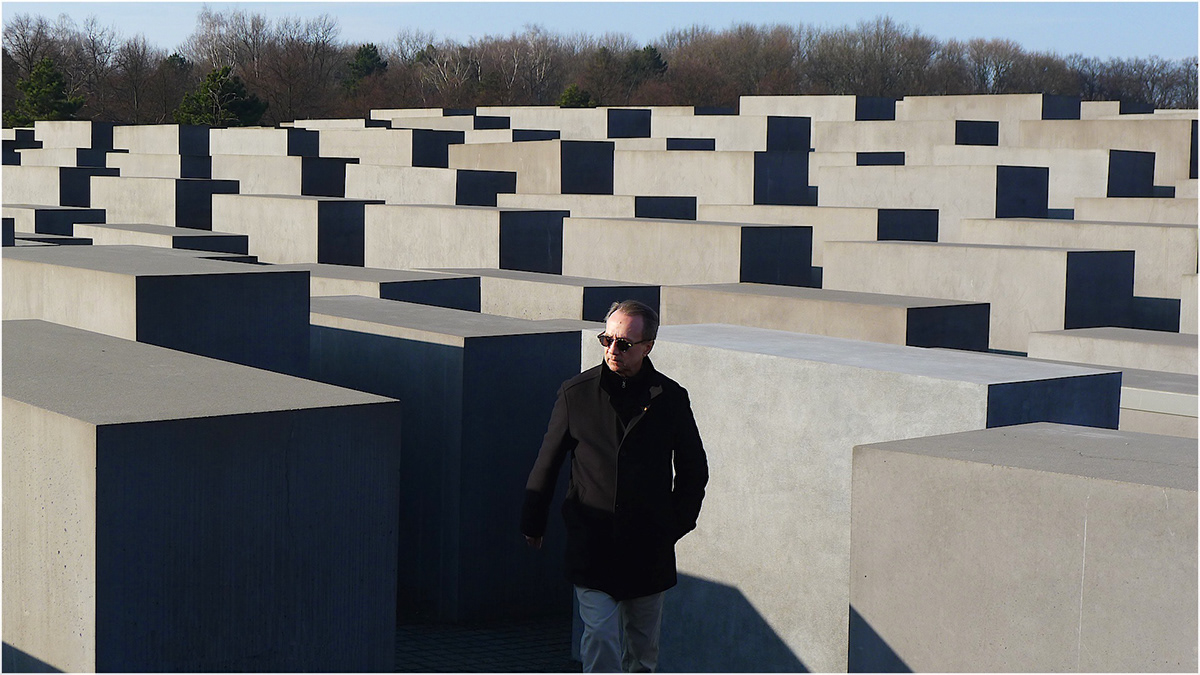

“Untitled - The State of The Art” (Berlin art magazine). September 2012 (English)
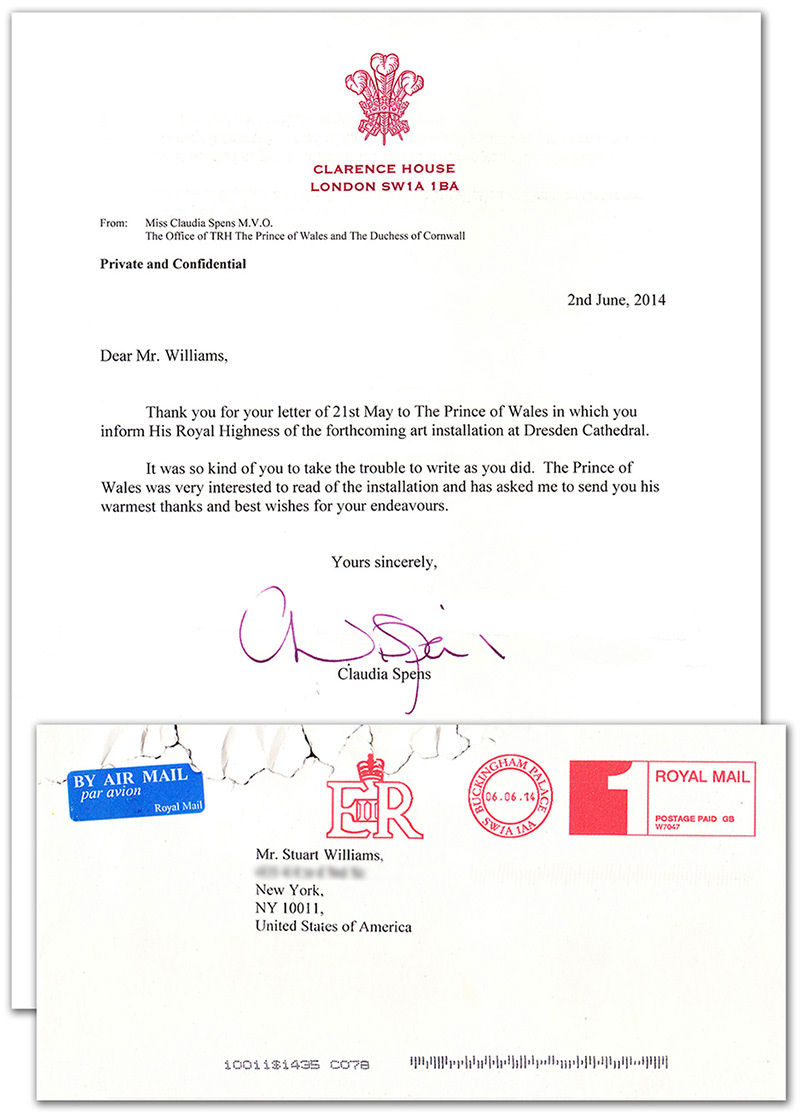
Endorsements:
“I attended this year’s commemoration of the bombing of Dresden, and I can confirm that this is a moving occasion. Thank you for your outstanding contribution (for the upcoming 2015 observance).”
– U.S. Consulate General; LEIPZIG, Germany / Teta Moehs, Acting Principal Officer
“Undoubtedly, this project is of utmost importance for the anniversary of the destruction of Dresden.”
– Allianz Kulturstiftung; BERLIN
“The Prince of Wales was very interested to read of the installation [at the Dresden Cathedral], and has asked me to send you his warmest thanks and best wishes for your endeavors.”
– Buckingham Palace; LONDON
“We consider Breath of Life/Dresden to be a very worthwhile enterprise.”
– Volkswagen Corporate Headquarters; WOLFSBURG, Germany
“Thank you for writing. I appreciate your passion for the arts and humanities.
I encourage you to keep speaking out and I wish you all the best.”
– President Barack Obama; THE WHITE HOUSE
Thank You to:
City of Dresden • Winfried Lehmann, Deputy Mayor
Free State of Saxony
Dresden Department of Culture and Monument Preservation
Dresden Kathedrale Ss. Trinitatis
Bischof Dr. Heinrich Koch, Dresden-Meißen
U.S. Embassy, Berlin
U.S. Consulate, Leipzig
Dresden Sister City, Inc.
Hotel Taschenbergpalais Kempinski Dresden
Westin Bellevue Dresden
Columbus Sister Cities International
Bishop Christopher, Bishop of Coventry, England
The Dresden Trust, London
WildKat PR, Berlin
New York Foundation for the Arts
“I attended this year’s commemoration of the bombing of Dresden, and I can confirm that this is a moving occasion. Thank you for your outstanding contribution (for the upcoming 2015 observance).”
– U.S. Consulate General; LEIPZIG, Germany / Teta Moehs, Acting Principal Officer
“Undoubtedly, this project is of utmost importance for the anniversary of the destruction of Dresden.”
– Allianz Kulturstiftung; BERLIN
“The Prince of Wales was very interested to read of the installation [at the Dresden Cathedral], and has asked me to send you his warmest thanks and best wishes for your endeavors.”
– Buckingham Palace; LONDON
“We consider Breath of Life/Dresden to be a very worthwhile enterprise.”
– Volkswagen Corporate Headquarters; WOLFSBURG, Germany
“Thank you for writing. I appreciate your passion for the arts and humanities.
I encourage you to keep speaking out and I wish you all the best.”
– President Barack Obama; THE WHITE HOUSE
Thank You to:
City of Dresden • Winfried Lehmann, Deputy Mayor
Free State of Saxony
Dresden Department of Culture and Monument Preservation
Dresden Kathedrale Ss. Trinitatis
Bischof Dr. Heinrich Koch, Dresden-Meißen
U.S. Embassy, Berlin
U.S. Consulate, Leipzig
Dresden Sister City, Inc.
Hotel Taschenbergpalais Kempinski Dresden
Westin Bellevue Dresden
Columbus Sister Cities International
Bishop Christopher, Bishop of Coventry, England
The Dresden Trust, London
WildKat PR, Berlin
New York Foundation for the Arts
Sponsors:
New York Foundation for the Arts
City of Dresden, Germany
Dresden Sister City Inc.
Columbus Sister Cities International
U.S. Embassy, Berlin
U.S. Consulate, Leipzig
Hotel Taschenbergpalais Kempinski Dresden
Westin Bellevue Dresden
WildKat PR, Berlin
An Anonymous Foundation in New York
Rudy Barton
Rhonda Barton
Libby Bassett
Laurel Blossom
Stanley Boles
Cheryl Brantner
Michelle Roy DeShazer
Susan Feldman
David Guthrie
Heather Guthrie
Pat Guthrie
Wendy Kahle
Dennis King
Marc Labadie
Diane Nance
Ted Olson
Jim Horn
Dennis King
Elizabeth Nogrady
Mariann Nogrady
Mike Nogrady
Norio Saito
Patricia Smith
Miriam Sontz
Leonard Todd
Dick Turner
Tom Urani
Joe Walsh
Additional Thanks to:
Kat Alder
Martial Barrault
Antje Beutekamp
Bauen mit Alpintechnik
Norbert Büchner
Cheryl Brantner
Christopher Burke
Martin Chidiac
Malcolm Cochran
Craig Collins
Suzanne Davidson
Eveline Eaton
Judith Eittinger
Dorit Fratzscher
Hermann Herlitzius
Dixon Miller
Teta Moehs
Diane Nance
Barbara Pratzner
Beate Renker
Scott Riedmann
Annedore Rudolph
Franziska Sender
Norbert Siedel
Jochen Schlattmann
Johannes Schulz
Michael Spamer
Günther Steimann
Bernd-Ulrich Tenner
Tina Thiele
Irene Schneider
Kristina Schoger
David Whitaker
Shelly Willis

The following five drawings indicate the location of LED lamps that were secured to the tower of the Dresden Cathedral, and specify the method of their attachment.

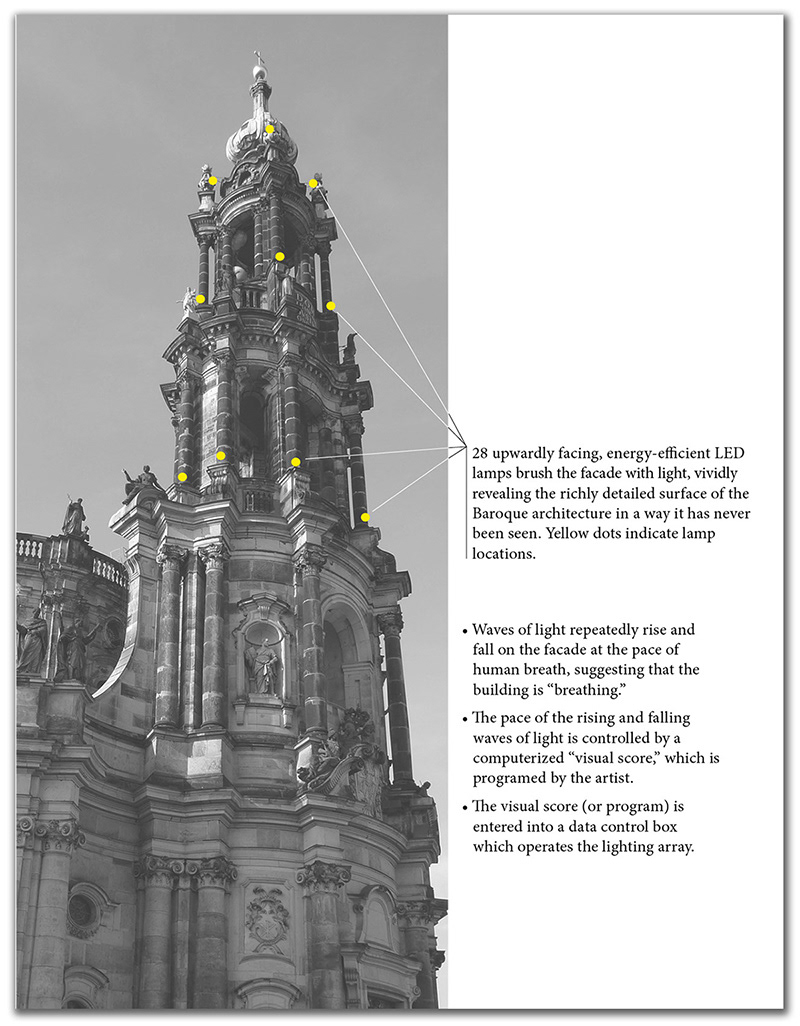

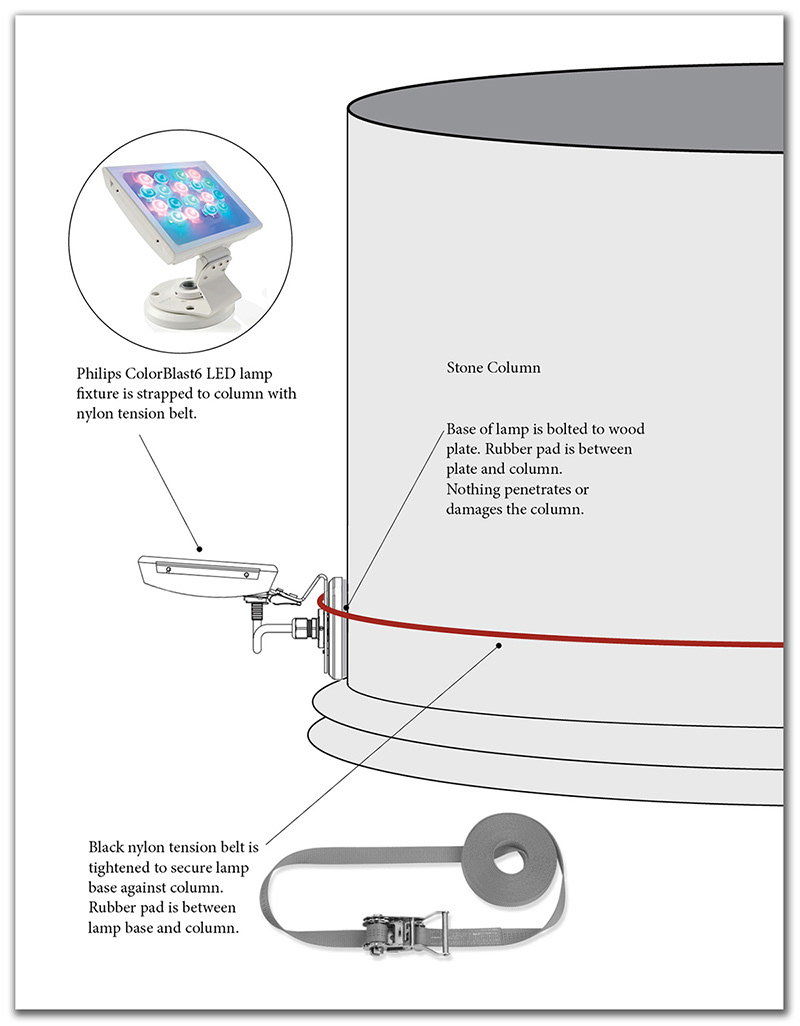
The above five drawings indicate the location of LED lamps that were secured to the tower of the Dresden Cathedral, and specify the method of their attachment.

